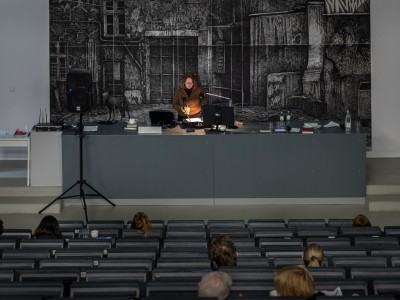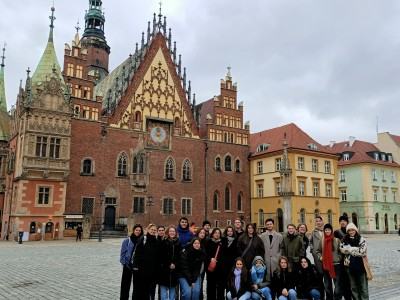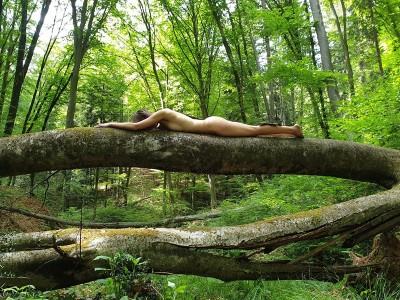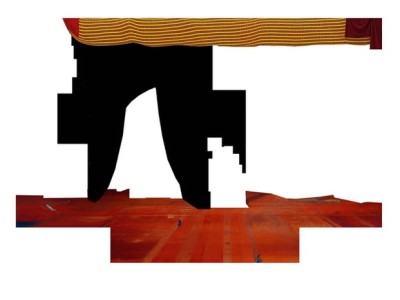The exhibition was carried out in cooperation between the National Museum in Wroclaw and the Eugeniusz Geppert Academy of Art and Design, the Faculty of Interior Architecture and Design.
The curators: Agata Danielak-Kujda, Giedymin Jabłoński.
The „Nature Morte Jewellery" came into existence as an initiative of Michael Petry - famous curator, artist, director of the Museum of Contemporary Art - MOCA London and Giedymin Jabłoński – artist, curator, academic teacher, one of the leading authorities in the field of art jewellery.
The exhibition presents more than 80 artists from all over the world, among them also teachers and students of the newly established Jewellery Studio at the Department of Design of the Eugeniusz Geppert Academy of Art and Design.
Participants of the exhibition (in alphabetical order of first names):
Adriana Lisowska & Aneta Lis-Marcinkiewicz PL,
Afke Golsteijn NL,
Agata Danielak Kujda PL,
Agata Nartowska PL,
Agata Nowosielska PL,
Aneta Regel PL/UK,
Andi Gut DE,
Andrea Wippermann DE,
Andrzej Boss PL,
Andrzej Pacak UK/PL,
Andrzej Szadkowski PL,
Anita Matysek PL,
Anna & Jacek Mydlarscy PL,
Bruce Metcalf US,
Carmen Amador ES,
David Clarke UK,
Diana Gladkaja LT,
Dovile Kondrasovaite LT,
Eeva Wornell FI,
Eija Mustonen FI,
Emily Valentine Bullock NZ,
Felieke van der Leest NO,
Fritz Maierhofer AT,
Giedymin Jabłoński PL,
Gijs Bakker NL,
Hans Stofer UK,
Herman Hermsen DE,
Hilde de Decker BE,
Helena Lehtinen FI,
Jarosław Westermark PL,
Jivan Astfalck UK,
Jorge Manila MX/BE,
Judy McCaig UK,
Karol Weisslechner SK,
Katerina Belkina RU/DE,
Katja Prins NL,
Kelly McCallum UK,
Ketli Titsar EE,
Kristi Paap EE,
Łukasz Huculak PL,
Mah Rana UK,
Małgorzata Kalińska PL,
Marek Rogulski PL,
Mari Ishikawa JP/DE,
Michael Petry UK,
Mindaugas & Asta Simkieviciai LT,
Mona Wallstrom SE,
Nanna Melland NO,
Nikola Weryk PL,
Nina Sajet NL,
Peter Skubic AT,
Petra Zimmermann AT,
Philip Sajet NL & Elisabetta Cappello IT,
Pierre Cavalan AU,
Przemysław Wańczyk PL,
Ramon Puig Cuyas ES,
Rima Zaveckaite LT,
Ruudt Peters NL,
Sara Gackowska PL,
Sari Liimatta FI,
Sergiusz Kuchczyński PL,
Sigurd Bronger NO,
Silvia Walz ES,
Sławomir Fijałkowski PL,
Tanel Veenre EE,
Tasso Mattar DE,
Ted Noten NL,
Tina Lilienthal UK,
Wojciech Kalandyk PL,
Zane Zukovska Skersiene LV,
Studentki:
Agata Stenkowska,
Agnieszka Ihnatowicz,
Agnieszka Pasek,
Agnieszka Tchórzewska,
Aleksandra Lubos,
Angelika Warzyc,
Katarzyna Konińska,
Katarzyna Rakowiecka,
Małgorzata Maternik,
Paulina Cieślewska,
Wiktoria Snela,
Zuzanna Trawińska
Place of presentation:
National Museum in Wroclaw, pl. Powstańców Warszawy 5, the main lobby / ground floor
Nature Morte - Jewellery
Together with the exhibition "NATURE MORTE – Contemporary Artists Reinvigorate the Still Life Tradition" the National Museum in Wrocław will present a second exhibition with a purposefully similar name: "Still Life – Jewellery." The first exhibition by Michael Petry, the well-known curator and director of MOCA London, was conceived as a travelling exhibition with a unique format where there is always an annexe from the host country. In Poland this annexe consists of works from the Wrocław National Museum's collection of historical and contemporary art. When the exhibition's Polish edition was at the planning stage, an idea to include art jewellery in this annexe emerged. During the work on the project, the idea to add a small collection turned into a project for a stand-alone international exhibition to accompany the main exhibition. This was determined by jewellery's special place as a relatively new and quickly developing medium of contemporary art. Artist's interest in jewellery began in European art in the Art Nouveau period and strongly grew in late Modernism. Next, looking for new areas in art, Postmodernism fully accepted jewellery's citizenship as a medium of artistic expression. This was determined by jewellery's relationship with the human body and its contextualism, resulting from the fact that in jewellery's case the communication process between artist and audience always has an extra element: the wearer. The context changes depending on that person, his or her gender, age, nationality, clothing, social status etc., and the situation the wearer and jewellery are in and, as a result, the final content of the artistic message. This property of jewellery and the possibility of the work transcending the gallery turned out to be especially attractive for many artists. At the same time, just as in all contemporary art, we can see a blurring of the borderline between jewellery and other art genres that has traditionally been separate from it.
One of the ideas behind this exhibition was to show the fluidity of these borderlines. Moreover, there is the subject of the still life, very atypical for jewellery, which, just like in the "mother exhibition," appears in various kinds of relationships with this traditional genre. There are analogies in the iconographic, symbolic and narrative spheres. Some pieces are clearly jewellery and still lifes, others conjure up associations with the subject matter through various kinds of similarities, analogies or tell about them. It is no coincidence that, besides the exhibition participants who make jewellery every day, there are artists who do mainly installations, painting, sculpture, ceramics, photography and video. Their work that combines various areas is an especially important element showing the fluidity of the borderlines between genres of contemporary art.
The exhibition can also aspire to be called pioneering because, in spite of the expansion of jewellery into the contemporary art scene that has been going on for well over half a century, it was so far shown at exhibitions and galleries that specialised in jewellery art. The first serious breakthrough was "Postmodernism," an exhibition at London's Victoria & Albert Museum in 2011. However, the jewellery their by a few select artists was only a small and part of the collection and was not shown separately. It is also worth noting that among the jewellery artists presented at this exhibition are names that belong to the genre's world elite.
The exhibition is organised by the Eugeniusz Geppert Academy of Fine Arts in Wrocław; its curators are Agata Danielak-Kujda and Giedymin Jabłoński, educators at the newly established Jewellery Studio at the Academy's Faculty of Interior Architecture and Design, so the exhibition also showcases the work of the Studio's students. Therefore, the young jewellery art apprentices (and the clear majority of them are women) have a rare opportunity to present their work next to that of celebrated, often world-famous artists and art school professors. It seems that this generational dialogue can be very interesting and fruitful for both sides.
The organisers hope that the exhibition will provide the visitors with many aesthetic experiences and interpretations that can sometime require a detective's effort in reaching the messages contained in the exhibited works. In conclusion, as a sort of 'hint,' allow me to note a very interesting insight by Charles Sterling, the distinguished still file painting scholar, who observed a certain common feature of the genre regardless of the era. In the foreword to his Still Life Painting: from Antiquity to the Twentieth Century, Sterling wrote: ". . . a genuine still life appears when the painter takes a fundamental decision to choose a group of objects as his subject and organises them into a certain whole. That he puts, depending on the time and environment in which he works, various spiritual allusions in them does not change anything in his deepest artistic intention which is to impose his poetic emotion in the face of the beauty he notices in these objects and their accumulation."
Viewing the "Still Life – Jewellery" exhibition it is worth pondering whether the above observation somehow concerns the exhibited pieces.
Giedymin Jabłoński
Translation: Piotr Łuba




